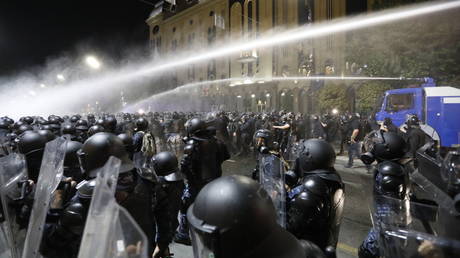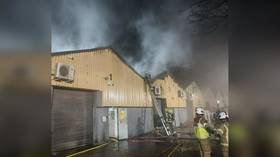Maybe We Should de-Fund the Police, by Robert Weissberg
Demands to defund police departments quite naturally raise the prospect of anarchy, or, as Thomas Hobbes would put it, “…the life of man, solitary, poor, nasty, brutish, and short” (Leviathan, i. xiii. 9). Nevertheless, this dystopian prospect need not be all that unwelcome, even for fans of strict law and order. And, going a step further in an unexpected direction, de-policing might create the harmonious racial segregation favored by both race realists and black separatists.
Begin by recognizing that policing is inherently selective, and selectivity ultimately rests on culture and it is hardly controversial to say that African Americans and whites typically embrace unlike cultures. It then follows that de-policing might create separate culture-based enclaves.
Moreover, not even the most crazed city council activist actually wants zero policing. Political leaders are always, at least to some degree, sensitive to tax-paying voters, and officials even on the Left will accept adequate law enforcement lest taxpayers flee and thus deplete budgets– no handouts and social engineering schemes. Those who demand protection will receive it, albeit from a police force that may not physically resemble the hard-boiled white cops of yesteryear.
The real issue behind de-policing concerns what occurs in black neighborhoods and stated plainly, inner city residents reject the “white” version of law and order. For many urban blacks, what most whites view as “law and order” resembles colonial rule imposed by an occupying foreign power. Again, it is not policing per se; it is who is arrested, for what offense and with what consequences. A felony in wealthy Palo Alto may be a petty nuisance in poverty-stricken East Palo Alto. It is a false dichotomy to insist that the battle is between law vs. anarchy.
Blacks and non-blacks just diverge on “quality of life.” To most middle-class whites, poor black neighborhoods are “plagued” by trash, gang graffiti, public intoxication, open petty drug-dealing, tricked-out cars drag racing on city streets, feral hookers, drunks sleeping it off on park benches, extensive loitering, people socializing with drivers in cars stopped in the middle of the road, food vendors without department of health certificate, irritating loud music, all behaviors technically unlawful but “normal” in these settings. A general ambiance that may be marginally legal but nevertheless irritates middle-class whites: dilapidated stores with garish signs, auto repair shops expropriating public sidewalks to park customer’s cars, venders hawking cheap made-in-China crap, over-grown trash-filled empty lots and abandoned cars peacefully at rest. Tellingly, efforts to clean up such “disorder” are futile—like weeds, conditions return almost immediately, and locals hardly seem bothered by the reemergence. In military terms, an invading army of gentrifying white hipsters may require years of pacification to “cure” a poor black area of its distinctive character.
De-policing may well bring good news for both the locals who appreciate their own quality of life and the police. Obviously, the locals will welcome police non-interference in activities culturally deemed normal and certainly not harmful (“victimless crimes” in sociology-speak). In fact, more than a few locals can only wonder why Washington invests millions in iffy tax-abatement schemes to revitalize the inner-city while simultaneously harassing profit-making business such ask hawking fake designer handbags.
Less obvious, but just as consequential, urban cops probably recognize that what they may personally view as pathologies are acceptable to many inner-city residents. They further know from past experience that enforcing the law against locals and their culture may well trigger riots. Yes, the corner crap game with its loud, intoxicated participants undermines urban quality of life, but breaking it up, arresting everyone and taking all the money as “evidence” (and the locals know that the money will vanish) may well spiral out of control. The upshot is that especially in light of recent mayhem—Baltimore, Ferguson etc., –abandoning policing here altogether would not entirely be unwelcome by the cops themselves save in extreme emergencies.
Today’s harsh colonial rule was not always the case. The regulation of gambling, prostitution, loan sharking, selling “hot” merchandise, and drug dealing among other tolerated ghetto behaviors was once handled largely by bribery, not forceful policing. The Mafia frequently ran ghetto rackets and paid off the police, and everything was peaceful since violence hurt business. Economic self-interest meant those selling liquor illegally or narcotics were motivated to keep order since fights would invite the police, hurt business and, worse, require a bribe. Gambling dens could not attract profitable high rollers if these customers felt uncomfortable by drunks sleeping in doorways. If somebody was to be taken out, it was accomplished professionally, not by self-appointed amateurs shooting into crowded funeral processions. To be sure, restoring Mafia rule or bribery would hardly transform the ghetto, but such non-police measures did reduce the odds of a police intervention going awry. The local crime boss would always relocate the corner crap game off the street so as not to temp a passing police officer, and only a crazy person would complain of harassment. In sum, home rule existed albeit often corruption based.
The financial benefits of urban “troop withdrawal” are considerable. Court dockets would shrink, there would be fewer parole and probation officers, fewer Public Defenders and with declining arrests, less mass incarceration. There is also a dirty little secret about geography based de-policing—few outside the inner city really care about violence and mayhem there. Actually, more than a few may welcome the killing provided outsiders were spared. As for society in general being overrun with criminals, miscreants would surely know that with culturally sensitive law-enforcement, better to avoid nicer neighborhoods were what is tolerated in the hood may bring jailtime elsewhere. Culturally sensitive policing cuts both ways.
What would de-policing look like? One possibility is offered by a Minneapolis group Building a Police Free Future that at least has given some thought to this possibility. Predictably, they reject the very idea of a police presence in the inner-city: “American police departments were originally created to dominate and criminalize communities of color and poor white workers, a job they continue doing to this day.”
Now for the good news: those demanding de-funding only want to target black neighborhoods, nothing pertains to whites, Asians or Hispanics. Boiled down to its essentials, it’s about getting the police off their backs, a world where, in effect, blacks can be blacks without being bossed around by culturally insensitive white cop outsiders (“strangers with guns”). It is assumed, moreover, that members of the community are capable of self-government, keeping the peace and preventing the mayhem so commonplace in today’s ghetto and if de-policing were put to a vote, it would win handily.
This self-sufficiency rests on creating the therapeutic state. To quote, “… we want to create space for more mental health service providers, social workers, victim/survivor advocates, religious leaders, neighbors, healers, and friends– all of the people who really make up the fabric of a community– to look out for one another.” Left unsaid, but obviously true, nearly all these therapeutic positions, paid for by police department budget cuts, will be largely filled by local African Americans. Everything just echoes the Great Society.
Will this therapeutic approach cut crime, make the inner city a better place to live? Who knows, but to the extent that crime exists exclusively as a statistic, the answer is “yes.” Crime will decline since it will be redefined and not officially be counted. An apprehended shoplifter might be counseled on the harm he has inflicted on the shopkeeper, and then released with no arrest (public schools call this approach “Restorative Justice”). There can be no police brutality or racist cops where there are no cops. As for murder, recall the days of the Wild West when those shot to death in a duel were “killed in a fair fight” and no homicide charges were filed (moreover, inner-city residents have seemingly acclimated to deadly shootings and a few more may not make much difference). And who ever heard of social worker brutality? In a setting where many crimes go unreported, barely anybody is charged, and conviction are rare, de-criminalization may be business as usual.
This community-based non-police approach is not as absurd or novel as it may initially appear. The Amish, Hasidic Jews among other religious sects typically settle all disputes among themselves without recourse to government funded police or courts. The Ottoman Empire flourished for centuries thanks to a system of millets where communities addressed their problems with their own laws. Ethnic-based gangs like the Russian Vory v Zakone similarly use this community law approach. Perhaps it really is time to abolish “strangers with guns.”
.




